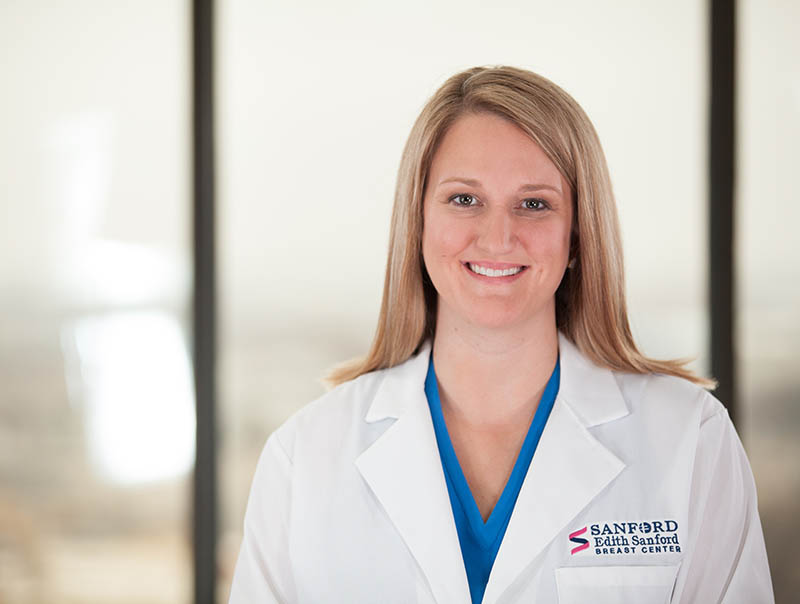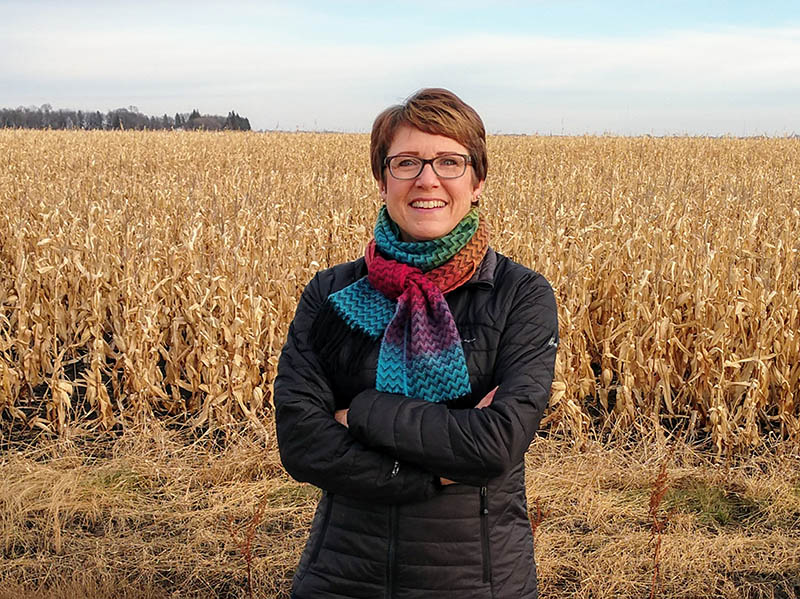Most patients with cancer spend just a small portion of their lives in active treatment, fighting the disease.
Treatment, while it may be all-consuming for a time, does end.
But the quality of the rest of each person’s life matters just as much as the treatment to Sanford Health medical oncologist Shelby Terstriep.
It’s so important to her that she has become an advocate for survivorship care on a national level. And now a new $1.8 million, five-year grant from the Centers for Disease Control and Prevention will allow Sanford Health to more quickly expand programs and innovate new ones, as well as learn from the other grant recipients.
Dr. Terstriep has seen survivorship care come a long way since she first started the Sanford Cancer Survivorship program 13 years ago. And the grant holds new promise.
“We’ve done so much already, but we’re excited to take it to the next level. OK, what’s the innovation? How can we be more accessible? How can we make this programming easier to execute across a rural footprint with technology? With innovation? With social networking?” she said. “We’re excited to push the envelope.”
Evolving survivorship care
Dr. Terstriep, who serves as medical director of the survivorship program, recalls its Fargo, North Dakota, roots. It started soon after she arrived to work in Fargo with the support of small grants and financial backing from what is now Sanford Health Foundation.
The first step then is similar to their first step now: working with focus groups to help pinpoint key concerns.
From those first focus groups, themes emerged, and new programming was designed. This included a survivorship clinic, where cancer patients meet with a variety of care providers to plan for rehabilitation after treatment, learn how to manage long-term side effects and learn how to watch for recurrence.
More: Breast cancer survivorship 101
A lecture series also began, in which specialists would address survivor-related concerns. The specialists began evolving into survivorship experts as they learned more about areas of interest to survivors, became more interested themselves and kept up with the latest literature, Dr. Terstriep said.
An annual retreat, called Revive, brings breast cancer survivors together each year to offer support, help with survivorship issues and educate about the latest advances. Support groups, private Facebook groups and mentors also are part of survivorship care.
Many pieces of programming have been extended to other regions of Sanford Health. Still more will be with this new grant.
Because insurance doesn’t cover a lot of what the survivorship program offers, resources generally have been limited for expanding quickly — until now.
While she believes wholeheartedly in the cutting edge nature of the program, Dr. Terstriep was still shocked when she found out Sanford Health had received the grant.
“Grants are really difficult to get nowadays,” she said. “There’s so many people working to get resources in health care.”
Goals for the grant
The grant’s specific goals aim to help young breast cancer survivors and survivors living with metastatic breast cancer — cancer that has spread to sites beyond the breast. It also will target particular challenges faced by Native American and LGBTQ patients who have breast cancer.
According to the American Cancer Society, 271,270 people in the United States will be diagnosed with invasive breast cancer, with roughly 10% of all cases occurring among women younger than 45.
“Younger women have increased survivorship needs, where you’re in the throes of fertility, dating, young children,” Dr. Terstriep said.
“The fear when you’re so young and you have so much life to live is much more magnified because you have those young children, or you have those dreams and hopes and things you have not been able to do yet.”
Dr. Terstriep offers one success story of a young breast cancer survivor. She knew she eventually wanted to become pregnant, so Sanford Health was able to harvest her eggs; find her a clinical trial about pregnancy outcomes; and offer fertility, psychology and integrative care services, along with a lecture series and online support group.
Thanks to survivorship care and fertility-sparing services, this patient has a healthy baby.
“I want that sort of outcome for everybody,” Dr. Terstriep said. “How can we create the opportunities … for that sort of support for all types of people, whether they’re in Fargo or whether they’re in a small town? I think that’s where the innovation comes.”
The grant will allow for expansion of a mentorship program and Stage IV support group to help address metastatic survivor needs, too.
“We’re going to get program coordinators in each region so that the ongoing support and planning and execution will be easier across the enterprise,” Dr. Terstriep said.
Being inclusive
While services associated with the grant specifically focus on breast cancer, Dr. Terstriep said the knowledge and tools will reach much further. “Whatever we are developing, it’s going to be for all cancer types.”
It’s especially important to Dr. Terstriep that programming inclusively meet the needs of all cancer survivors.

For Native American women, she envisions reaching out to organizations, tribal leaders and the Great Plains Tribal Chairmen’s Health Board and examining how to adapt and create programming — mentorships, for example — to better meet their needs, wherever they live.
Persons identifying as LGBTQ+ have the same health care needs as their straight peers. But they also have unique disparities because of stigma and a shortage of culturally affirming care. For example, greeting a patient at the reception desk with an emergency contact confirmation, using the assumptive term “husband,” can immediately put a female patient with a wife in an uncomfortable position of interrupting the check-in process to explain her relationship before continuing to the next question.
If subtle communication issues continue into the examination room, patients may feel discouraged from being open with their provider about their sexuality. That can leave health or quality-of-life issues left undiscussed, and maybe even influence the frequency of visits and lead to disparities in seeking health care.
Dr. Terstriep’s goal is to implement training to increase LGBTQ+ culturally affirming care among staff members and decrease institutional bias by adding inclusive language to forms, educational materials and policies.
Beyond staff training, Dr. Terstriep wants to be sure the LGBTQ+ population throughout the geographic area is represented in other ways, such as through mentorship programs, and she wants to look into programming that can help remove some barriers.
Suggestions for change
Denise Kaeslin met Dr. Terstriep in 2012 after her breast cancer diagnosis, when Dr. Terstriep became her medical oncologist.
Kaeslin hadn’t before taken the risk of disclosing to a doctor that she is a lesbian. But when she did so during that especially vulnerable time, she was relieved when Dr. Terstriep accepted it matter-of-factly: “Oh, OK.”
“I think it’s our duty as physicians to be accepting,” Dr. Terstriep said.
Kaeslin placed her complete trust in Dr. Terstriep’s plans for her treatment, which included chemotherapy and radiation following a double mastectomy.
In the years since then, Kaeslin has made observations and suggestions about the health care environment to Dr. Terstriep. The oncologist values Kaeslin giving voice to experiences that other patients might silently notice or struggle with.
“That creates drive for me to want to change something,” Dr. Terstriep said.
For example, at Kaeslin’s suggestion, language about intimacy or sexuality topics presented at the Revive breast cancer survivor retreats became more inclusive.
“Unintentionally, we say things that can make them feel marginalized,” Dr. Terstriep said. “And that’s what we can really change.”
To reach out and encourage screenings among the LGBTQ population, Dr. Terstriep started coming to the annual Fargo-Moorhead Pride celebration with the Sanford Health mobile mammogram truck. Kaeslin has served as a volunteer with the truck. She thinks it offers a welcoming presence and a chance to educate the rural LGBTQ community about what a mammogram machine looks like and its importance in catching breast cancer early.
“The LGBTQ population, they’re at a greater risk of late diagnosis, just because they’re not coming in for screening,” Kaeslin said. “So that reduces their chance of successful treatment and survival.”
‘Looking forward to the positive work’
Kaeslin wrote a letter to accompany the grant application in which she called Dr. Terstriep her advocate and explained what a difference LGBTQ-affirming and inclusive care can make.
“I’m just looking forward to the positive work that this grant is going to lead to,” Kaeslin said.
Collaboration will be central in many aspects of the grant, including learning best practices from other grant recipients, Dr. Terstriep said. Another will involve Sanford Health developing inclusive and culturally competent sexual health education and support for cancer survivors.
Collaborative efforts also are happening within Sanford Health. Survivorship care is being embraced throughout the organization.
“It’s that infrastructure and that team who really are dedicated to this work who have allowed us to get the grant. … It’s so many people that are inspired by this work and inspired by our patients,” Dr. Terstriep said.
It all works toward Dr. Terstriep’s dream for every patient, everywhere: “That they have the right support at the right time in the right method.”
Learn more
- What you need to know about dense breast tissue
- Breast cancer survivor’s kindness at retreat changes her life
- Cancer & intimacy: Sanford docs add to an app for that
…
Posted In Cancer, Cancer Screenings, Cancer Treatments, Imaging, Innovations, News, People & Culture, Sanford Stories, Women's
